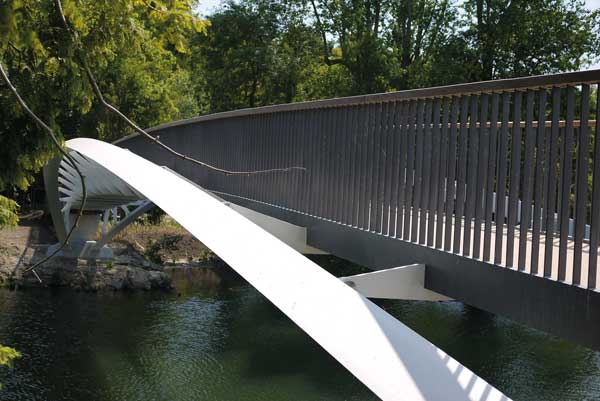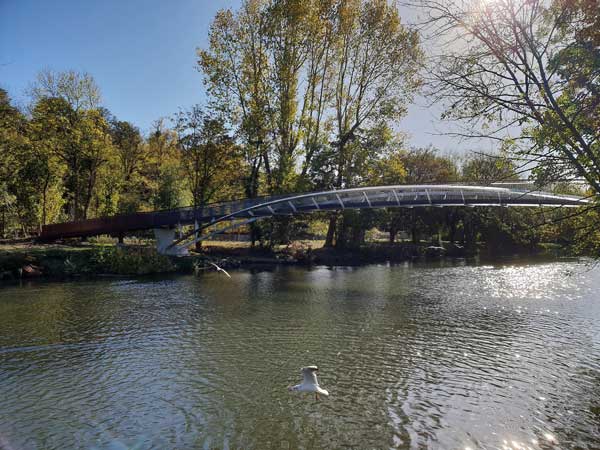SSDA Awards
Award: Taplow Riverside Footbridge
 The latest Thames crossing is a slender, sculptural form that was erected in an area of natural beauty with limited construction access.
The latest Thames crossing is a slender, sculptural form that was erected in an area of natural beauty with limited construction access.
FACT FILE
Architect: Knight Architects
Structural engineer: COWI
Steelwork contractor: S H Structures Ltd
Main contractor: Land & Water
Client: Berkeley Group
Opened in November 2018, the Taplow Riverside Footbridge is the latest crossing of the River Thames and provides a new pedestrian link in the Thames Path to connect a riverside development with Maidenhead.
Spanning 40m, the shallow arch form of the design is inspired by Brunel’s nearby Maidenhead Bridge and is echoed in the slender steel box structure.
Fabricated triangular-section box girders form the twin structural arches that support the deck, while slender steel hangers complete the composition and ensure the structure is lightweight and transparent in river views.
Initially a truss-type footbridge was proposed for the site, but this was criticised by local residents, who felt the design was industrial-looking and out of character with the area.
This prompted Berkeley Homes to appoint Knight Architects and COWI to develop a slender and elegant design to suit the natural beauty of the site and enhance user experience while still being cost-effective.
 “The site for the bridge presented numerous access challenges,” explains COWI Project Manager Clare Taylor.
“The site for the bridge presented numerous access challenges,” explains COWI Project Manager Clare Taylor.
“The only viable access route for construction was the river and so it was important to design a bridge that could be constructed easily and safely from the water without compromising the bridge aesthetics within this picturesque setting.”
This challenge was solved by using steel as the primary material as it allowed the bridge to fabricated offsite in one piece.
Another important consideration was steelwork’s high structural strength and stiffness as it provided the only possible material to realise the architect’s vision of a very slender bridge for this site.
The steel structure was designed with structural efficiency in mind but allowing a clear architectural identity to be developed. It consists of three key features: the arch, deck and flat plate hangers.
The arches are triangular in cross section and lean outwards to produce a dramatic visual effect, opening up the views from the bridge of the river and surrounding landscape.
The arch geometry was devised to avoid double curvature to facilitate fabrication from sheet steel, and the triangular shape results in a much greater transparency, emphasising the slenderness of the design.
White was chosen as the colour of the arch as it stands out within the natural backdrop, while adding to the slender appearance and giving an attractive profile along the river.
“The arches support a remarkably slender composite steel-concrete deck formed by a steel tray comprising the edge beams and bottom plate, which was filled with in-situ concrete after the bridge was installed,” says Ms Taylor.
“Transverse stiffeners are revealed below and extend outwards to form the hangers. This composite construction results in improved structural behaviour, particularly from the point of view of dynamic response and acoustics, but also facilitated easy construction.”
The flat plate hangers, with expressed pinned joints at their ends, provide lateral stability to the arch, enabling greater slenderness than if wire strands had been used.
The shortest hangers experience some out-of-plane bending due to relative longitudinal movement between deck and arch. To keep the same thickness and maintain the desired transparency, which was a key architectural desire, the designers used higher grades of steel for these hangers.
Offsite fabrication by S H Structures was a key factor in the project as this enabled a high-quality finish to be achieved and allowed for a trial assembly to be carried out, ensuring a more efficient on-site build.
“Installation was the most significant challenge with limited access to the site. This meant a conventional crane could not be used and so the bridge had to be delivered by river,” says S H Structures Sales Director Tim Burton.
The structure was transported in three parts by road to a laydown and assembly yard a short distance downstream of the bridge site.
The bridge was assembled on temporary works, before the entire steel structure was then lifted onto a pontoon, floated upriver and installed using hydraulic jacks in a single one-day operation.
The use of steel was key to permitting this method of installation, which significantly reduced the time, energy, cost, disruption and environmental impact of more traditional methods. All aspects of the project were driven by the need to simplify installation as much as possible. This included designing the parapet to be installed with the offsite steelwork to provide a safe environment for all subsequent construction activities on the bridge deck.
Durability was another important aspect of the bridge’s design. The careful detailing of the structure facilitates easy long-term maintenance. The entire structure is also painted to a high standard, including the arches which were designed from the start as a sealed, painted section.
The ends of the arches have a simple end plate detail, with a knuckle arrangement, which allowed rotation during concreting of the deck to reduce bending effects and minimise plate thicknesses. This was then cast into the abutment on completion to act as a fixed end for live load effects, avoiding the use of a bearing at these points for a maintenance-free solution, which is particularly crucial as they are below flood level.
The judges say, this elegant bridge comprises twin steel arches, triangular in section, with the deck suspended via inclined steel plate hangers. The result is a distinctive, slender structure providing a valuable link between communities and fitting in sensitively with its environment. The steelwork is beautifully detailed, and trial assembly helped ensure trouble-free installation, using barges on the river, despite challenging conditions.
Photo 1 © Knight Architects









